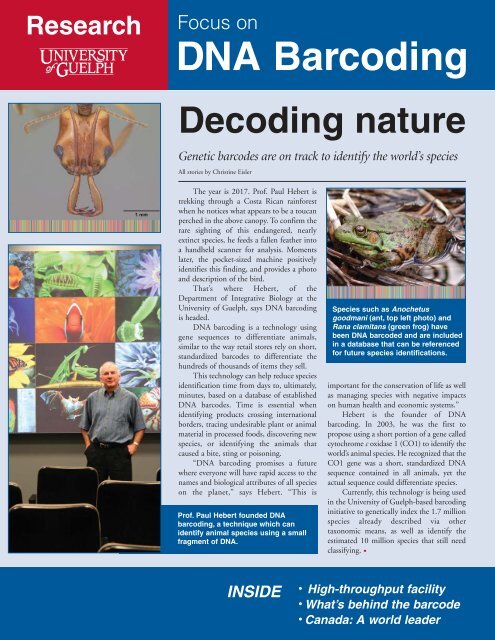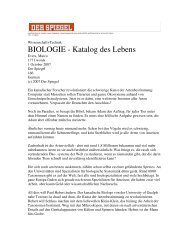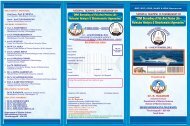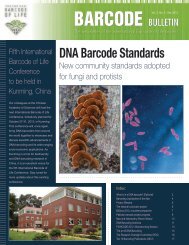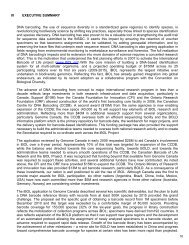Focus On DNA Barcoding - University of Guelph
Focus On DNA Barcoding - University of Guelph
Focus On DNA Barcoding - University of Guelph
You also want an ePaper? Increase the reach of your titles
YUMPU automatically turns print PDFs into web optimized ePapers that Google loves.
Research<br />
<strong>Focus</strong> on<br />
<strong>DNA</strong> <strong>Barcoding</strong><br />
Decoding nature<br />
Genetic barcodes are on track to identify the world’s species<br />
All stories by Christine Eisler<br />
The year is 2017. Pr<strong>of</strong>. Paul Hebert is<br />
trekking through a Costa Rican rainforest<br />
when he notices what appears to be a toucan<br />
perched in the above canopy. To confirm the<br />
rare sighting <strong>of</strong> this endangered, nearly<br />
extinct species, he feeds a fallen feather into<br />
a handheld scanner for analysis. Moments<br />
later, the pocket-sized machine positively<br />
identifies this finding, and provides a photo<br />
and description <strong>of</strong> the bird.<br />
That’s where Hebert, <strong>of</strong> the<br />
Department <strong>of</strong> Integrative Biology at the<br />
<strong>University</strong> <strong>of</strong> <strong>Guelph</strong>, says <strong>DNA</strong> barcoding<br />
is headed.<br />
<strong>DNA</strong> barcoding is a technology using<br />
gene sequences to differentiate animals,<br />
similar to the way retail stores rely on short,<br />
standardized barcodes to differentiate the<br />
hundreds <strong>of</strong> thousands <strong>of</strong> items they sell.<br />
This technology can help reduce species<br />
identification time from days to, ultimately,<br />
minutes, based on a database <strong>of</strong> established<br />
<strong>DNA</strong> barcodes. Time is essential when<br />
identifying products crossing international<br />
borders, tracing undesirable plant or animal<br />
material in processed foods, discovering new<br />
species, or identifying the animals that<br />
caused a bite, sting or poisoning.<br />
“<strong>DNA</strong> barcoding promises a future<br />
where everyone will have rapid access to the<br />
names and biological attributes <strong>of</strong> all species<br />
on the planet,” says Hebert. “This is<br />
Pr<strong>of</strong>. Paul Hebert founded <strong>DNA</strong><br />
barcoding, a technique which can<br />
identify animal species using a small<br />
fragment <strong>of</strong> <strong>DNA</strong>.<br />
Species such as Anochetus<br />
goodmani (ant, top left photo) and<br />
Rana clamitans (green frog) have<br />
been <strong>DNA</strong> barcoded and are included<br />
in a database that can be referenced<br />
for future species identifications.<br />
important for the conservation <strong>of</strong> life as well<br />
as managing species with negative impacts<br />
on human health and economic systems.”<br />
Hebert is the founder <strong>of</strong> <strong>DNA</strong><br />
barcoding. In 2003, he was the first to<br />
propose using a short portion <strong>of</strong> a gene called<br />
cytochrome c oxidase 1 (CO1) to identify the<br />
world’s animal species. He recognized that the<br />
CO1 gene was a short, standardized <strong>DNA</strong><br />
sequence contained in all animals, yet the<br />
actual sequence could differentiate species.<br />
Currently, this technology is being used<br />
in the <strong>University</strong> <strong>of</strong> <strong>Guelph</strong>-based barcoding<br />
initiative to genetically index the 1.7 million<br />
species already described via other<br />
taxonomic means, as well as identify the<br />
estimated 10 million species that still need<br />
classifying. •<br />
INSIDE<br />
• High-throughput facility<br />
• What’s behind the barcode<br />
• Canada: A world leader
Raising the bar<br />
High-throughput facility boosts volume <strong>of</strong> species identified<br />
Canada’s <strong>DNA</strong> barcoding efforts have<br />
gained momentum with the newly opened<br />
Biodiversity Institute <strong>of</strong> <strong>On</strong>tario (BIO)<br />
facility at the <strong>University</strong> <strong>of</strong> <strong>Guelph</strong>.<br />
The new facility, a $4.2-million,<br />
15,000-square-foot building, opens<br />
opportunities for heightened research<br />
productivity. It will help fast track <strong>DNA</strong><br />
barcoding technology’s introduction to<br />
public use for applications such as border<br />
control or pest management.<br />
BIO is home to the Canadian Centre<br />
for <strong>DNA</strong> <strong>Barcoding</strong> (CCDB). This centre<br />
develops laboratory protocols and maintains<br />
the Barcode <strong>of</strong> Life Data System, an online<br />
data management system which is central to<br />
the global barcoding community for<br />
maintaining barcode records and being<br />
a resource to diagnose unknown animals.<br />
CCDB also serves as core facility and<br />
headquarters for researchers in the Canadian<br />
Barcode <strong>of</strong> Life Network, enabling them to<br />
gather and share ideas and information to<br />
advance <strong>DNA</strong> barcoding research.<br />
“Our location in BIO has allowed us to<br />
concentrate our resources to become a highthroughput<br />
facility for <strong>DNA</strong> barcode<br />
analysis and production,” says Alex Smith,<br />
BIO research program co-ordinator.<br />
In the past, <strong>DNA</strong> barcoding research<br />
was based out <strong>of</strong> a single laboratory at the<br />
<strong>University</strong> <strong>of</strong> <strong>Guelph</strong>. This location was<br />
capable <strong>of</strong> processing up to 75,000 samples<br />
for barcoding each year.<br />
But now, BIO’s launch dramatically<br />
raises that capacity. Heightened production<br />
in all aspects <strong>of</strong> barcode research and new<br />
equipment at the facility will result in an<br />
anticipated output <strong>of</strong> 500,000 barcode<br />
analyses per year. And improved efficiencies<br />
are expected to reduce barcoding costs in the<br />
new facility.<br />
“The productivity levels that we are now<br />
able to reach should help ensure that the<br />
global effort to barcode all animal species will<br />
continue to be based in <strong>Guelph</strong>,” says Smith.<br />
Funding for the BIO building and<br />
barcoding research is provided in part by<br />
Genome Canada through the <strong>On</strong>tario<br />
Genomics Institute. Additional funding for<br />
BIO comes from the Canada Foundation for<br />
Innovation and the <strong>On</strong>tario Innovation<br />
Trust. <strong>Barcoding</strong> research is sponsored<br />
through the Gordon and Betty Moore<br />
Foundation, the Natural Sciences and<br />
Engineering Research Council, the <strong>On</strong>tario<br />
Research Fund and various federal and<br />
private sector organizations. •<br />
Alex Smith, BIO research program co-ordinator (left), and biology<br />
pr<strong>of</strong>essor Bob Hanner say <strong>DNA</strong> barcoding technology is steadily<br />
progressing because <strong>of</strong> heightened research activity at <strong>Guelph</strong>.<br />
Funding for <strong>DNA</strong> <strong>Barcoding</strong><br />
at the <strong>University</strong> <strong>of</strong> <strong>Guelph</strong><br />
February 2007<br />
<strong>On</strong>tario<br />
Innovation<br />
Trust<br />
Canada Foundation<br />
for Innovation<br />
Natural<br />
Sciences and<br />
Engineering<br />
Research<br />
Council<br />
Gordon and Betty<br />
Moore Foundation<br />
Genome<br />
Canada<br />
Federal,<br />
provincial<br />
and other<br />
sources<br />
Canada Foundation<br />
for Innovation<br />
Federal, provincial<br />
and other sources<br />
Genome Canada<br />
Gordon and Betty<br />
Moore Foundation<br />
Natural Sciences and<br />
Engineering Research Council<br />
<strong>On</strong>tario Innovation Trust<br />
Total<br />
$5 million<br />
$2 million<br />
$5 million<br />
$3 million<br />
$5 million<br />
$5 million<br />
$25 million<br />
Research | <strong>Focus</strong> on <strong>DNA</strong> <strong>Barcoding</strong>
What’s behind<br />
the barcode<br />
Developing a method to identify every<br />
living species on Earth is no easy order, but<br />
<strong>University</strong> <strong>of</strong> <strong>Guelph</strong> researchers have found<br />
a way to do it. With a small fragment <strong>of</strong><br />
<strong>DNA</strong> from a portion <strong>of</strong> a single gene, they<br />
can characterize nearly any animal species<br />
on earth.<br />
Pr<strong>of</strong>. Paul Hebert, Department <strong>of</strong><br />
Integrative Biology, and his colleagues,<br />
including Pr<strong>of</strong>. Bob Hanner, are working<br />
with a gene called cytochrome c oxidase 1<br />
(CO1), to distinguish one species from<br />
another. CO1 is found in the mitochondria<br />
– the powerhouses <strong>of</strong> cells in living creatures.<br />
CO1 plays a pivotal role in providing energy<br />
to the cell.<br />
The advantage <strong>of</strong> using CO1 for<br />
identification is that it’s short enough to be<br />
quickly and inexpensively sequenced, yet<br />
long enough to set apart variations<br />
among species. (Use <strong>of</strong> the CO1 gene is a<br />
straight forward method to help identify<br />
animal species, but does not apply to all life.<br />
Further research at the Canadian Centre for<br />
<strong>DNA</strong> <strong>Barcoding</strong> and the Canadian Barcode<br />
<strong>of</strong> Life Network is focused on isolating<br />
standardized genes that will identify<br />
plant species.)<br />
“This gene allows for rapid and<br />
accurate identification,” says Hanner. “It has<br />
proven success in species discovery and<br />
identification from many divergent animal<br />
groups, from ants to birds.”<br />
There are five main steps involved in<br />
obtaining CO1 <strong>DNA</strong> sequences.<br />
First, a specimen must be collected, and<br />
identified by a taxonomist.<br />
Then, a tissue sample is obtained from<br />
the specimen and digested to make the <strong>DNA</strong><br />
accessible so it can be isolated and extracted.<br />
The <strong>DNA</strong> is then amplified (copied) in<br />
a specialized chemical environment using a<br />
process called polymerase chain reaction,<br />
which makes copies <strong>of</strong> the specific gene<br />
fragment for sequencing.<br />
<strong>On</strong>ce amplified, the <strong>DNA</strong> is sequenced<br />
to generate a barcode.<br />
Finally, the barcode is entered into the<br />
Barcode <strong>of</strong> Life Data System (BOLD),<br />
which manages the growing number <strong>of</strong><br />
barcode sequences. It is an online system to<br />
help researchers from across Canada and<br />
around the world to collect, manage and<br />
analyze <strong>DNA</strong> barcodes.<br />
Each entry organized in BOLD has<br />
information such as the animal’s taxonomic<br />
name, its picture, GPS co-ordinates for<br />
where it has been found, and its barcode<br />
sequence.<br />
This information is accessible through<br />
BOLD to anyone in the world and<br />
will have many applications, including<br />
environmental monitoring, food safety<br />
and medicine. For example, <strong>DNA</strong> barcoding<br />
will be used to identify the larvae <strong>of</strong><br />
invasive pests, discover new species, identify<br />
the species that caused a bite, sting<br />
or poisoning, monitor biomaterials crossing<br />
international borders and verify plant or<br />
animal ingredients in foods. •<br />
<strong>Guelph</strong> researchers such as<br />
Katy Hind are working with a gene<br />
called cytochrome c oxidase 1,<br />
which is found in the cells <strong>of</strong> all<br />
animals, to distinguish one<br />
species from another.<br />
Research | <strong>Focus</strong> on <strong>DNA</strong> <strong>Barcoding</strong>
Canada: A world leader in<br />
<strong>DNA</strong> barcoding technology<br />
From humble beginnings in a small<br />
laboratory, to establishing the Canadian<br />
Centre for <strong>DNA</strong> <strong>Barcoding</strong> and the<br />
Biodiversity Institute <strong>of</strong> <strong>On</strong>tario, the<br />
<strong>University</strong> <strong>of</strong> <strong>Guelph</strong>’s <strong>DNA</strong> barcoding<br />
research program has experienced a massive<br />
evolution since its inception in 2003.<br />
The progress has propelled Canada to a<br />
position <strong>of</strong> leadership and innovation in<br />
using <strong>DNA</strong> barcoding technology. <strong>Guelph</strong><br />
researchers lead the Canadian Barcode <strong>of</strong><br />
Life Network and play a significant role in a<br />
number <strong>of</strong> international barcoding efforts,<br />
including campaigns to barcode fish, birds,<br />
butterflies and moths.<br />
Canada has been at the forefront in<br />
collecting <strong>DNA</strong> and developing tools to<br />
manage the barcoding data. The Barcode <strong>of</strong><br />
Life Data System (BOLD) was created at<br />
<strong>Guelph</strong> as a means to organize, analyse and<br />
query all <strong>DNA</strong> barcodes. BOLD has been<br />
universally adopted by all major<br />
international barcoding campaigns, helping<br />
to build a reference library <strong>of</strong> barcodes in<br />
one central location.<br />
Through the determined efforts <strong>of</strong><br />
highly skilled researchers and support from<br />
diverse organizations and specimen<br />
collections, Canada is making key<br />
contributions to a biological research<br />
program that will have economic, social and<br />
environmental applications, both nationally<br />
and internationally. •<br />
The <strong>DNA</strong> barcoding team:<br />
propelling <strong>Guelph</strong> to a position<br />
<strong>of</strong> leadership and innovation.<br />
For more information<br />
Canadian Centre for <strong>DNA</strong> <strong>Barcoding</strong><br />
www.dnabarcoding.ca<br />
Canadian Barcode <strong>of</strong> Life Network<br />
www.bolnet.ca<br />
Barcode <strong>of</strong> Life Data System<br />
www.barcodinglife.org<br />
Biodiversity Institute <strong>of</strong> <strong>On</strong>tario<br />
www.biodiversity.ca<br />
<strong>Focus</strong> on <strong>DNA</strong> <strong>Barcoding</strong> is written by student participants in SPARK (Students Promoting Awareness <strong>of</strong> Research Knowledge), Office <strong>of</strong> Research, <strong>University</strong> Centre,<br />
Room 437, <strong>University</strong> <strong>of</strong> <strong>Guelph</strong>, <strong>Guelph</strong>, <strong>On</strong>tario N1G 2W1 >> Phone: 519.824.4120 Ext. 58278 >> Fax: 519.821.5236 >> E-mail: info@research.uoguelph.ca >><br />
Website: www.uoguelph.ca/research >>Editor: Owen Roberts >> Editorial Co-ordination: Christine Eisler and Kim Waalderbos >> Photography: Larry Evon,<br />
April Nobile (www.antweb.org), Kyle Rodriguez and David Trattles >> Design and Layout: JnD Marketing >> First Printing: February 2007.<br />
SPARK participation in the <strong>Focus</strong> on <strong>DNA</strong> <strong>Barcoding</strong> has been facilitated by Genome Canada through the <strong>On</strong>tario Genomics Institute.<br />
Research | <strong>Focus</strong> on <strong>DNA</strong> <strong>Barcoding</strong>


